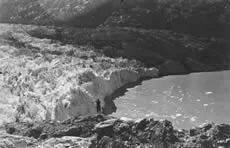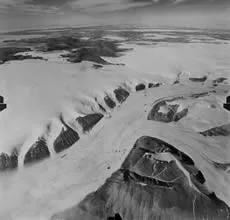Cryosphere glossary
ice wedge
narrow ice mass that is 3 to 4 meters (10 to 13 feet) wide at the ground surface, and extends as much as 10 meters (33 feet) down; a decrease in temperature during the winter leads to ice wedge cracks in the ground around ice wedges; during the summer, these cracks accumulate melt-water and sediment, forming pseudomorphs.
ice worm
an oligochaete worm that lives on temperate glaciers or perennial snow; there are several species that range in color from yellowish-brown to reddish-brown or black; they are usually less than 1 millimeter (0.04 inch) in diameter and average about 3 millimeters (0.1 inch) long; some eat red algae.
ice-bearing permafrost
permafrost that contains ice.
ice-bonded permafrost
ice-bearing permafrost in which the soil particles are cemented together by ice.
ice-cemented glacier
a rock glacier that has interstitial ice a meter or so below the surface.
ice-cored glacier
a rock glacier that has a buried core of ice.
ice-cored topography
topography that is due almost solely to differences in the amount of excess ice underlying its surface.
ice-nucleation temperature
the temperature at which ice first forms during freezing of a soil/water system that does not initially contain ice.
ice-rich permafrost
permafrost containing excess ice.
ice-wedge cast
a filling of sediment in the space formerly occupied by an ice wedge.
ice-wedge polygon
a polygon outlined by ice wedges underlying its boundaries.
iceberg
a piece of ice that has broken off from the end of a glacier that terminates in water.
Image

Lamplugh Glacier, in Glacier Bay Alaska, shows the terminus of a typical tidewater glacier. The terminus of the glacier is heavily crevassed and jagged, and is calving small icebergs. For scale, note the man standing on the rocks in the foreground (near the center of the photograph). This photograph was taken in 1941.
W. O. Field, archived at the World Data Center for Glaciology, Boulder, CO
iceberg tongue
a major accumulation of icebergs projecting from the coast, held in place by grounding and joined together by fast ice.
icebound
a harbour, inlet, etc, is said to be icebound when navigation by ships is prevented due to ice, except possibly with the assistance of an icebreaker.
icefall
part of a glacier with rapid flow and a chaotic crevassed surface; occurs where the glacier bed steepenes or narrows.
Image

Icefalls on three parallel glaciers.
Tom Lowell, University of Cincinnati
icefield
a mass of glacier ice; similar to an ice cap, and usually smaller and lacking a dome-like shape; somewhat controlled by terrain.
Image

Kalstenius Icefield, located on Ellesmere Island, Canada, shows vast stretches of ice. The icefield produces multiple outlet glaciers that flow into a larger valley glacier. The glacier in this photograph is three miles wide.
Royal Canadian Air Force, archived at the World Data Center for Glaciology, Boulder, CO
icefoot
a narrow fringe of ice attached to the coast, unmoved by tides and remaining after the fast ice has broken free.
Icelandic low
the low pressure center near Iceland (mainly between Iceland and southern Greenland); on mean charts of sea-level pressure, it is a principal center of action in the atmosphere circulation of the northern hemisphere.
iceport
an embayment in an ice front, often of temporary nature, where ships can moor alongside and unload directly into the ice shelf.
icicle
hanging spike of clear ice formed by the freezing of dripping water.